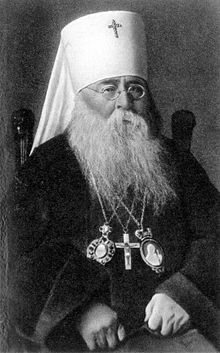Sergius I (Patriarch)
Sergius ( Russian Сергий , wiss. Transliteration Sergij ; born as Iwan Nikolajewitsch Stragorodski , Иван Николаевич Страгородский; * January 11th jul. / January 23rd 1867 greg. In Arsamas ; † May 15, 1944 in Moscow ) was the Deputy Archbishop of the Patriotic Administrator of Moscow 1925 to 1943 and as the 12th Patriarch of Moscow and All Russia from 1943 to 1944 head of the Russian Orthodox Church .
Life
Sergius was born as Ivan Nikolajewitsch Stragorodski into a family of clergymen. His grandfather and father were priests in his hometown, his aunt was superior of a nunnery there. Stragorodski studied theology and became a monk and monk priest in 1890 under the name Sergi .
1890–1893 and 1897–1899 he served in the Russian Orthodox Mission in Japan , 1893/1894 he was deputy rector of the Moscow Theological Academy , 1894–1897 he was Archimandrite head of the Russian Orthodox Church in Athens .
From 1899–1901 he was director of the Theological Seminary, and later of the entire Academy in Saint Petersburg . On February 25, 1901, the episcopal ordination took place in the Trinity Church of the Alexander Nevsky Monastery by the Metropolitan of St. Petersburg Antoni Wadkowski . He initially worked as Bishop of Jamburg until he became Archbishop of Finland and Vyborg on October 6, 1905 . On August 10, 1917, he became Archbishop of Vladimir and Shuja , then elevated to the rank of Metropolitan by Tikhon . In the same year he became a permanent member of the Holy Synod . Arrested by the communists and banished from Moscow to Novgorod , he was Metropolitan of Novgorod from 1924 to 1934.
Since after the death of Patriarch Tikhon (1925) the communist government prevented the election of a new patriarch and Metropolitan Peter von Krutitsy , who was elected patriarchal administrator, was soon imprisoned, Sergius managed the fortunes of the Russian Orthodox Church as deputy head.
In 1927 he signed a declaration of loyalty from the church to the Soviet state power.
In 1934 he became Metropolitan of Moscow and Kolomna.
At the beginning of the German attack on the Soviet Union , Sergius called on the faithful on June 22, 1941 to take part in the defense of the fatherland and expressed his conviction of a Soviet victory. During the war, Stalin promised the church considerable improvements in its situation, including permission to elect a new patriarch, the reopening of the Moscow Theological Academy, and the return of expropriated church property. In this way he tried to secure her further support. At the end of December 1942 he called on the Orthodox believers to donate money for the erection of a tank column. At the beginning of March 1944 this tank column was handed over to the Red Army by Metropolitan Nikolaus Yaruschevich under the historically evocative name of " Dmitri Donskoi " . Sergius was unanimously elected Patriarch of Moscow and All Russia on September 8, 1943. He was thus able to officially exercise his existing leadership position as patriarch until his death nine months later. The late patriarch was buried in the Epiphany Cathedral in Moscow.
literature
- Kurt Alisch: Patriarch Sergius and his intellectual legacy , Berlin 1952, Union-Verlag
- Patriarchs of All Russia , in: The Journal of the Moscow Patriarchate 10 (1989), pp. 10-16 (about Sergius I on p. 13 f.).
Individual evidence
- ↑ Hans-Dieter Döpmann : The Russian Orthodox Church in Past and Present, Union Verlag Berlin 1977, p. 254.
Web links
- Article at Orthodoxwiki
- Biographies , Chronos (Russian)
| predecessor | Office | successor |
|---|---|---|
| Tikhon |
Patriarch of Moscow 1943 - 1944 |
Alexius I. |
| personal data | |
|---|---|
| SURNAME | Sergius I. |
| ALTERNATIVE NAMES | Сергий (Russian); Sergij (scientific transliteration); Stragorodski, Ivan Nikolajewitsch (maiden name) |
| BRIEF DESCRIPTION | Patriarch of Moscow (1943–1944) |
| DATE OF BIRTH | January 23, 1867 |
| PLACE OF BIRTH | Arsamas |
| DATE OF DEATH | May 15, 1944 |
| Place of death | Moscow |
